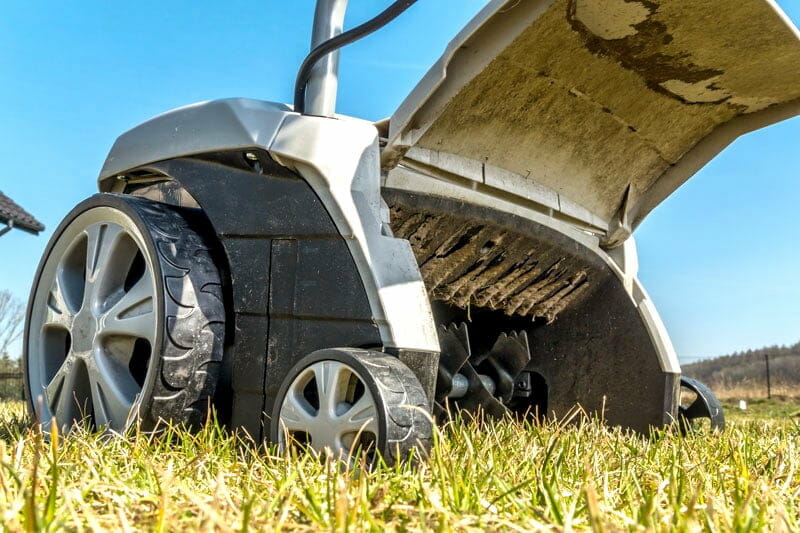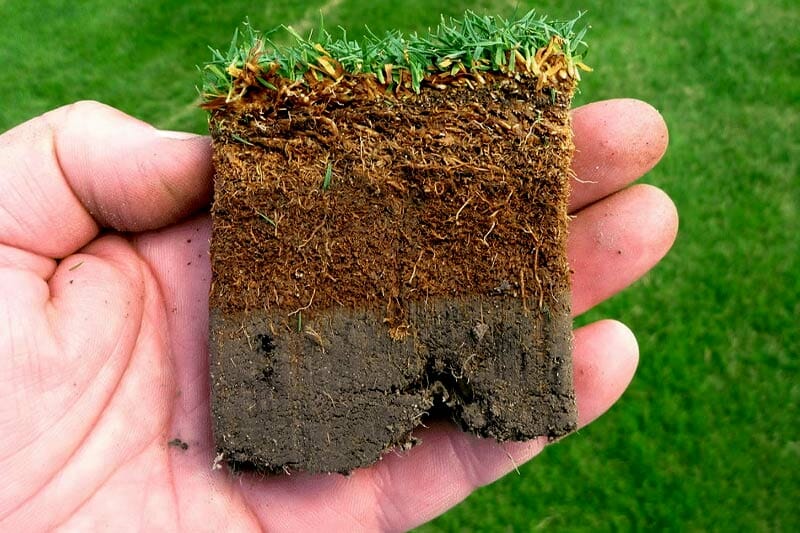Is it common to use both dethatching and power raking as techniques for lawn maintenance to remove thatch? Do they differ from one another?
No, power raking is not the same as dethatching. While both processes involve removing thatch from a lawn, power raking tends to be a more aggressive approach to thatch removal. It is relatively more expensive and far more suited for commercial use. On the other hand, dethatching is a less-aggressive and more affordable approach to thatch removal. It is thus ideal for use on average-sized lawns.
Here is everything that you need to know.

What are the similarities between power raking and dethatching?
Before we explore the differences, let’s look at the similarities between the two.
Both get rid of thatch
Both dethatching and power raking are lawn maintenance routines that are designed to get rid of the thatch in the lawn.
What is thatch?
Thatch is a layer that develops between the grass blades and the soil. It is usually made up of roots, leaves, stems, and dead grass.

Why do you need to get rid of it?
While the layer can help to reduce the rate at which the lawn loses moisture, it can be problematic. It can:
- Attract pests
- Become so thick that it reduces aeration
- Keep new seeds from reaching the soil, hence starving them out
- Reduce fertilizer and moisture penetration in your lawn
- Reduce the aesthetic appeal of the lawn
Power raking and dethatching help
These two lawn maintenance techniques help to break down this layer. And by so doing:
- free up the lawn
- improve aeration
- increase moisture penetration
- ensure that your lawn’s roots get nutrients from applied fertilizers, and
- improve the appearance of your lawn
Therefore, in terms of overall purpose, these two lawn maintenance routines have similarities.
However, they are not the same.
What is the difference between power raking and dethatching?
Here is a breakdown of the differences between power raking and dethatching.

Tools
Dethatching requires the use of dethatchers, while power raking uses a power raker.
These two tools are different.
Dethatchers tend to be smaller than power rakers. They require less power than power rakers. And are generally less aggressive at removing thatch.
Depth
Generally, power raking involves removing thatch to depths of over 1/2 inches. Dethatching, on the other hand, involves removing thatch to within 1/2 inches.
Therefore, when compared to dethatching, power raking involves removing thicker layers of thatch.
Intensity
When compared to dethatching, power raking is a way more aggressive lawn maintenance technique. It removes way more thatch — up to 4 times more– and is thus usually reserved for extreme cases of thatch development.
Dethatching is a less-aggressive process. It is often used where there is mild thatch development.
Recovery time
Given that power raking is more aggressive than dethatching, power-raked lawns tend to take a longer time to recover. This is because they have experienced way more trauma.
Generally, dethatching is limited to removing thatch no deeper than 1/2 inch. It is a less aggressive form of power raking. And it uses relatively smaller equipment. As a result, it tends to put less stress on the lawn.
Use
They differ in terms of how these techniques are used.
Where it is used
Power raking
Power raking is usually used on commercial lawns.
Power rakers are perfect for large commercial lawns since keeping track of the thatch thickness in these lawns is usually a challenge. Their thatch is more likely to overgrow in thickness, a problem that power rakers are designed to solve.
Therefore, power raking is often reserved for larger sprawling commercial lawns.
Dethatching
On the other hand, dethatching is often reserved for small to medium-sized lawns.
Since these lawns are smaller, it is easy to keep track of any developing thatch. This is so especially when you consider the fact that a once-a-year thatch removal schedule is all that it takes to keep everything under control.
In short, dethatching is ideal for regular-sized lawns that are often found in most homes. Power raking, on the other hand, is ideal for large lawns.
Who uses it
Power raking
Power rakers are incredibly powerful and aggressive. They can easily damage a lawn. And they are more suited for use on commercial lawns.
Therefore, lawn care professionals are the ones who regularly use them.
Dethatchers
Dethatchers are not as aggressive as power rakers. Therefore, they are a little bit more forgiving of mistakes.
Beginners or people who lack lawn care expertise can easily use them without the risk of causing significant damage to their lawns. They are thus perfect for use by DIY homeowners.
Cost
Power rakers are powerful. They are also larger. As a result, they tend to be pricier. This, in turn, makes it expensive to power-rake a lawn.
On the other hand, thanks to their relatively smaller size and the use of less-powerful motors, dethatchers are generally more affordable. As a result, dethatching tends to be the more affordable option of the two.
What are the benefits of power raking over dethatching?
The main advantage of power raking is that it removes way more thatch than what dethatching can get. In some cases, it can remove up to 4 times more thatch than what you can typically remove with a dethatcher.
What this means is that power raking is a superior process in terms of effectiveness. It can power through thick thatch layers. And it can do so effectively without breaking a sweat. It is thus suited for lawns with a really thick thatch problem.
What are the benefits of dethatching over power raking?
Dethatching has an advantage over power raking. Here are the ones that stand out.
It is gentler on your lawn
Dethatchers are not as aggressive as power rakers. They are designed to get rid of thatch that is about 1/2 inches thick. By nature, dethatching is thus a less aggressive process.
Being less aggressive means that it is a lawn maintenance activity that does less damage to the lawn. It doesn’t dig as deep, which means that it will have less of a negative effect on the health and appearance of your lawn.
Faster recovery time
Since it is not as aggressive as power raking, it does less damage. This often translates to a faster recovery time. This means that you will have your lawn back to its former glory way faster — when compared to power-raked lawns.
It is more affordable
Power rakers use way more powerful motors than dethatchers. They are also larger. This usually makes them more expensive than dethatchers.
Therefore, if lawn maintenance cost is something that you care about, dethatching is a better option. It requires less expensive equipment, and it is thus more affordable.
It is more forgiving for beginners
Dethatchers are not as aggressive as power rakers. They have significantly less power. This makes them a little bit friendlier for home use as the potential for causing significant damage to a lawn is lower.
Therefore, if you are not a lawn care professional, opting for dethatching may be better as it is more forgiving. It has less potential for causing irreparable damage to your lawn.
Use this FREE service to find an expert near you
If you need help power raking or dethatching your lawn, use this FREE service.
HomeGardenGuides.com offers a free service that puts you in contact with qualified lawn professionals in your area.
Here is how it works.
- You scroll to the top of the page and enter your Zip code.
- Answer questions about your needs and preferences
- Your details will be forwarded to three local experts.
- You will then receive a price estimate – in writing – for the job and some friendly advice.
IMPORTANT: There is no obligation to hire. This is a free tool and service to be used at your pleasure.

FAQ's
If you are working on your lawn, you should use a dethatcher.
A dethatcher is powerful enough to take care of an average-sized lawn. This is because these lawns rarely have thatch layers that are thick enough to warrant the extra power of a power rake.
Furthermore, dethatchers are more affordable. And as a beginner, they are ideal because they carry less of a risk of damaging your lawn.
Power rakes are perfect for professionals who work with commercial lawns. And while their power is appreciated in commercial settings, it is unnecessary when it comes to at-home use.
However, if you have a neglected lawn that has more-than-average thatch thickness, then going for a power rake might be advisable.
Technically, a power rake dethatches. This is because, just like dethatchers, they remove thatch layers from lawns.
However, they tend to be used in commercial settings. This is because they are a more aggressive, bigger, and more powerful version of dethatchers.
Yes, you can dethatch with a regular rake.
However, it will be a cumbersome process. It will also be ineffective. And might end up causing a lot of trauma to your lawn. This is because a regular rake isn’t designed to effectively and efficiently remove thatch from a lawn.
Using a dethatcher is always advisable.






